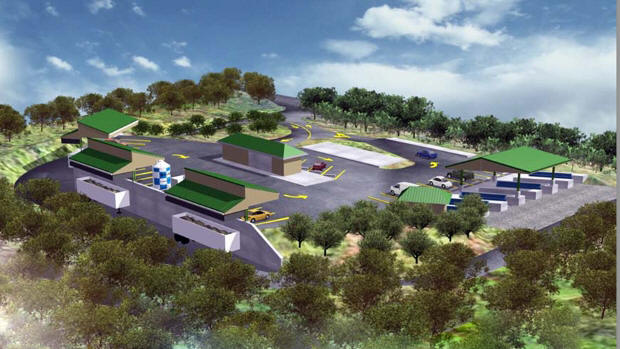Hawaiian says transfer station is 'most beautiful place' on
the Big Island
Speaker says, 'If you build it (pretty), recyclers will come'
- September 25, 2012
- By Jeremy Carroll @jeremyscarroll
 Courtesy, Terin Gloor
Just by updated the look of the
transfer station on the main island of Hawaii, the county
saw an increase in recycling.
Courtesy, Terin Gloor
Just by updated the look of the
transfer station on the main island of Hawaii, the county
saw an increase in recycling. National Harbor, Md. — The most beautiful facility on all of the big island of Hawaii? Well, a transfer station, of course.
"We had an elected official call this the most beautiful place in [the entire] island," said Terin Gloor, senior engineer for the county of Hawaii, amongst laughs.
Gloor spoke about an effort to increase recycling and get residents to take pride in waste disposal in Hawaii during Wastecon in National Harbor, Md., just outside of Washington D.C.
There is no curbside pickup on the main island of Hawaii, and 21 drop off facilities accept various types of waste and recycling. The transfer stations force residents to sort items themselves, or dump it all in the garbage for disposal at the landfill.
"Culturally in Hawaii, the land was divided from the mountain type to the sea," said Gloor. "And these divisions, in ancient Hawaii, were indentified to handle all the resources of the community in that land division."
Each is supposed to be able to dispose of its own waste and not be a burden on the neighboring area.
These stations were largely developed in the 1970s and have fallen in disrepair. In 2007, the county decided to take a hard look at building a new model of a transfer station.
"We picked the worst transfer stations and we wanted to look at how we could take them from their current life into this century, how we could meet the needs of the growing demands for our community," Gloor said.
They also aimed to see if a better design would allow for higher recycling rates.
After a retaining wall collapsed, the Pahoa transfer station was chosen as the site for the new station, and the facility was built for $3.9 million in 10 months. The results were remarkable, Gloor said.
The facility went from what looked like an area where trash simply accumulated – white goods and scrap metal were collected in piles on dirt – to a drive-up facility with bins for various types of waste.
The county saw an immediate change. There was a 15% increase in the amount of materials recycled as a direct result.
"By good design, we were able to change behavior," Gloor said.
Residents once viewed the place as a dump, but are now actively take pride in it, Gloor said. He recalled a story of a resident dropping materials while throwing items away. Instead of just leaving it, the resident grabbed a broom, swept up the mess and dumped it into the rubbish area.
"That behavior never would have happened before," he said.
The 2-acre site includes various renewable energy aspects, including solar electricity and rainwater harvesting.
"The only bill we have is the phone bill," he said.
And while calling it the most beautiful facility in the entire state might be a stretch, Gloor said the community has really taken ownership of the transfer station.
"The sense of community in this site has changed dramatically," he said.
![]()
w w w . w a s t e r e c y c l i n g n e w s . c o m
copyright 2012 by Crain Communications Inc. All rights reserved.